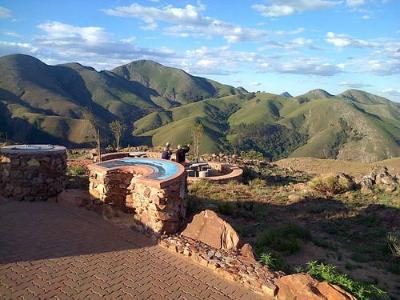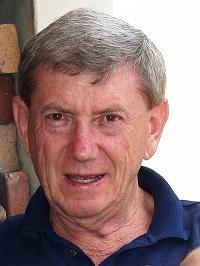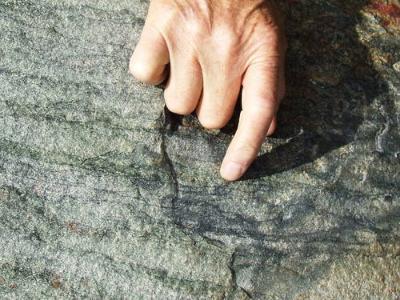Window into the world’s early days
-
South Africa’s newest UNESCO World Heritage Site, the Barberton Makhonjwa Mountains, is a place of geological superlatives. Our understanding of why this is so, and the fact that the area is now protected from uncontrolled development, are due largely to the work of Wits University researchers and alumni. This is where we can see some of the world’s oldest rocks and signs of life, beautifully preserved, providing insight into the evolution of the early earth.

Hundreds of papers and several books on the area have appeared over the last 60 years, largely authored by Wits geoscience researchers.
The close association between Wits and the Barberton Makhonjwa Mountains began in 1957 when the Economic Geology Research Unit (EGRU; later EGRI) was established under the late Professor Des Pretorius, focusing on gold mineralisation. Researchers in this field have included Ned Poole, Carl Anhaeusser, Morris Viljoen, Nick Gay, Richard Viljoen, Rudolf Saager, Mike Wuth, Chris Roering and Trevor Pearton.
Many other lines of research developed over the years and were carried out through international projects, among them the Upper Mantle Project (from the early 1960s) and the International Geodynamics Project (from the late 1960s).
The Viljoens’ mapping of the Komati River valley, in the southern part of the Barberton Mountains, revealed a remarkably well preserved succession of rocks which were unlike any other volcanic rock that had been described at that time. The rocks’ very high magnesium content and distinctive texture put them in a new class of their own, and they are now recognised as an important part of the story of the early earth. They are found in the oldest segments of all the continents. Known as komatiites, they were formed when lava crystallised at a much higher temperature than other lavas, and they are associated with nickel and gold deposits. The Viljoens jointly received the Lindgren Award of the Society of Economic Geologists in America in 1979 for the discovery of komatiite.


The exceptional preservation of the rocks of the Barberton Mountains attracted worldwide attention in the mid to late 1960s. In 1967 Prof. Preston E Cloud Jnr from the University of California, Santa Barbara and Dr Keith Kvenvolden, a geoscientist from NASA, were introduced to the area by the Viljoens. Signs of organic material representing primitive life forms were identified in black carbonaceous, silica rich sediments (cherts). Since that time researchers, mainly from the USA and Europe, have carried out numerous studies on these ancient sediments, many of which are sandwiched between komatiitic lava flows. Abundant evidence of microbial communities akin to present day cyanobacteria and algae have been described. It is surmised that there could well be an important link between the ultra-magnesium rich nature of the earth’s oldest komatiitic oceanic crust and the early life forms producing magnesium-based chlorophyll. The process of photosynthesis of the earliest life forms produced the first free oxygen in the oceans.
Wits geoscientists were also heavily involved in the South African contribution to the International Geodynamics Programme, which took place mainly during the 1970s. The main aim of the programme was to obtain an understanding of the early crustal evolution of southern Africa. Outstanding contributions were made by Wits’ Carl Anhaeusser and Laurence Robb, complemented by the studies of Dave van Nierop. Other Wits geoscientists who were involved in the Geodynamics project from time to time included Jay Barton, Rod Fripp, Maarten de Wit and Ian Stanistreet.

Sedimentary rocks interlayered between komatiite lava flows have yielded important clues as to the evolution of the early earth. Studies by Ken Eriksson established how some of the sediments were laid down in a tidal setting at a time when the moon was far closer to the earth than at present.
Uwe Reimold described evidence for the oldest known meteorite impacts on the planet and Carl Anhaeusser described stromatolites formed in an environment dominated by hot spring emissions and evaporite brines.
Many of the significant sedimentary features can be seen on the recently established Makhonjwa Geotrail which traverses the Barberton Mountains. Visitors can see bands of rock rich in iron oxides formed when the planet got its first taste of free oxygen. The earliest life, microbial mats preserved as black carbonaceous slivers, is visible along the trail. Excellent interpretive plaques and a guidebook by Tony Ferrar and Christoph Heubeck provide a superb overview.

Carl Anhaeusser, who succeeded Prof. Pretorius as Director of EGRU and spent many years carrying out research in the area, suggested that parts of the Barberton Mountain Land needed protection and should be declared a UNESCO World Heritage Site. He provided a list of 300 sites together with descriptions and motivations.
Tony Ferrar, an environmentalist and tour guide, and Dion Brandt, a Wits geology PhD graduate, drove the preparation of the application to UNESCO. Besides the geology, other components such as cultural heritage, fauna, flora and existing protected sites such as nature reserves and conservancies were incorporated into the application.
The World Heritage Site was proclaimed in June 2018 – and Wits researchers continue to work on understanding more about this global treasure.
The Viljoens have a passion for geoheritage and geotourism, helping people to understand the influence of geological features on nature and on human activity. Their efforts include leading walks in the Kruger Park (a book is in production) and producing explanatory material about the Vredefort Dome for visitors to Parys.
The 50th anniversary of the discovery of komatiite and the recent establishment of the World Heritage Site will be celebrated in August 2019 with a geoheritage trip to Barberton, organised by the Geological Society of South Africa.
[To see picture captions, place cursor over images.]


